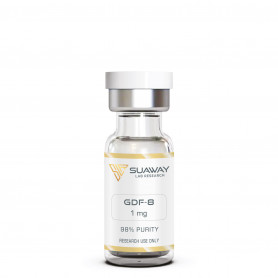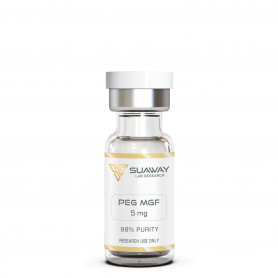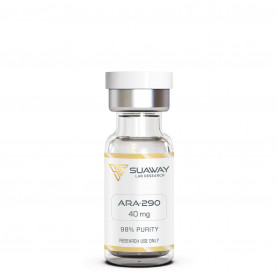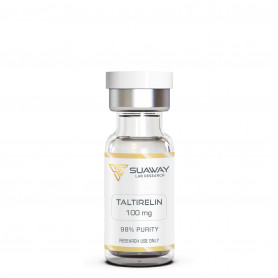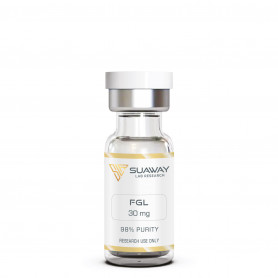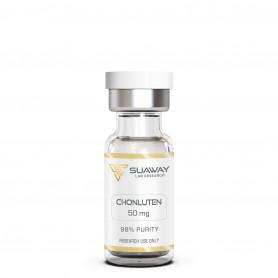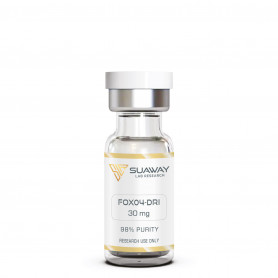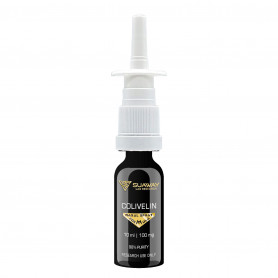cAC-253 - 10mg
Cyclic AC-253, also known as cAC-253, is a new and potent amylin receptor antagonist that has been shown to alleviate
cognitive impairments in Alzheimer's disease.
It has been shown to have the effects that are listed below:
- Enhancement of spatial memory as well as learning
- Enhancement of synaptic integrity
- Decrease in the amount of amyloid plaque in the brain
- Decrease in neuroinflammatory activity
Description
STRUCTURE
Sequence: CLGRLSQELHRLQTYPRTNTGSNTYC (Modifications: Cys-26 = C-terminal amide, Disulfide bridge between 1 - 26)
Molecular Formula: C126H202N42O40S2
Molecular Weight: 3009.36 g / mol
PubChem ID: 134160250
Peptide purity: greater than 98%
Other details: No TFA Salt, No Mannitol
Storage: Lyophilized peptide must be stored at -20 ° C and peptide solution at + 4 ° C
cAC-253 has low oral and excellent subcutaneous bioavailability.
DESCRITPION
Amylin receptor acts as a gateway for the development of the harmful effects of amyloid beta-protein (A), which is a fundamental pathologic characteristic of Alzheimer's disease. According to research, the amylin receptor antagonist AC253 is neuroprotective against A toxicity in vitro and abrogates A-induced impairment of hippocampus long-term potentiation.
Mice that overexpress Amyloid Precursor Protein were given AC253 for five months. It was determined how pathologic alterations were measured biochemically and immunohistochemically while cognitive functions were observed and analyzed.
cAC253 boosted synaptic integrity while also enhancing learning and memory of spatial relationships.
Alzheimer's disease has a therapeutic target known as the amylin receptor, which might lead to the development of a disease-modifying treatment for this illness.
Alzheimer's disease (AD) is the most prevalent type of dementia. This kind of dementia is defined by the deposition of amyloid beta-protein (Aβ) both intracellularly and extracellularly inside cortical and limbic brain areas that are essential for memory and cognitive functioning. In Alzheimer's disease (AD) research, the topic of whether the amyloid protein is a cause or a consequence of the illness is one of the most important questions. At this point, it seems that the probable answer is both. Multiple lines of evidence strongly suggest a role for Aβ in the etiology of Alzheimer's disease (AD):
1) AD is related to hereditary amyloid precursor protein (APP) mutations;
2) neurotoxicity of soluble oligomeric A when administered to neurons;
3) APP-overexpressing animals that recreate some neuropathologic and behavioral characteristics of AD.
Multiple receptors have been involved in the mechanism by which Aβ disrupts neuronal and synaptic processes in AD. As a result, these receptors have been identified as prospective targets for the development of anti-Aβ therapeutics; however, none of these medicines have yet achieved this objective. It is important to note that the amylin receptor acts as a gateway for the manifestation of harmful effects caused by Aβ and human amylin (hAmylin). Amylin is a 37-amino acid peptide hormone that's also consecrated with insulin by beta cells of the pancreas that regulate glucose levels in the blood. Despite this, amylin can aggregate and form amyloid oligomers and fibrils in the pancreas of people with type 2 diabetes and the brains of people with Alzheimer's disease (AD).
According to research, hAmylin, like Aβ, induces malfunction and death in neurons that are disproportionately impacted by Alzheimer's disease. In addition, amylin receptor antagonists are neuroprotective against Aβ-induced toxicity and have the ability to reverse the impairment of Aβ- or hAmylin-induced depression of hippocampal long-term potentiation (LTP), which is a cellular surrogate for memory. One example of an amylin receptor antagonist is AC253, which is a 24-amino acid peptide.
It has been shown that continuous treatment of the amylin receptor antagonist, AC253, improves learning and memory impairments in transgenic APP-overexpressing (TgCRND8) mice. This was discovered by testing the in vivo therapeutic effectiveness of AC253 in an AD animal model. These behavioral benefits occurred at the same time as an increase in proteins associated with synapses, such as synapsin 1 and synaptophysin, and a reduction in the microglia marker, Iba1. A brand new disulfide head-to-tail cyclized form of the AC253 peptide has undergone development and testing (cAC253). When compared with its linear equivalent, AC253, cAC253 exhibits superior proteolytic stability and pharmacokinetic characteristics, as well as higher brain penetration after a single intraperitoneal (ip) administration. Importantly, by using a panel of genetically engineered mice with varying levels of amylin receptor expression, we were able to show that systemically administered cAC253 is strongly localized to the hippocampal region, which happens to coincide with the distribution of amylin receptors in the brain, and that its concentration in the brain correlates with the expression levels of the amylin receptor in the brain. This finding is significant because it demonstrates that the hippocampal region is the primary site In conclusion, intraperitoneal (i.p.) injection of cAC253 for ten weeks (three times per week) attenuates cognitive decline and improves learning and memory deficits in TgCRND8 mice. This improvement takes place in conjunction with a decrease in the amount of A deposits found in the brain. The results indicate that the amylin receptor is a feasible target for disease-modifying treatments in Alzheimer's disease (AD) and that the amylin receptor antagonist, cAC253, is a novel prospective therapeutic option in AD patients. Taken together, these findings highlight the amylin receptor as a viable target for disease-modifying therapies in AD.
The widespread use of linear peptides as treatments is constrained by several significant limitations, including rapid metabolism by proteolytic enzymes and inadequate pharmacokinetics. As a consequence of this, the researchers placed two cysteine residues at both the C and N termini of the cAC253 structure and then cyclized it by forming disulfide bonds between them. This resulted in a conformational constraint being placed on the cAC253 structure.
After peripheral delivery, peptidergic medicines must acquire an effective concentration in the central nervous system to be a useful treatment for Alzheimer's disease (AD). Therefore, using fluorescently labeled peptides, researchers compared and contrasted the ability of cAC253 and AC253 to cross the blood-brain barrier (BBB) in mice using NIR fluorescence in vivo and ex vivo brain imaging. This was done to determine which of the two peptides was more effective at crossing the barrier. The fluorescence signal for both peptides was greatly elevated in the brain following a single delivery through the intraperitoneal route, and it was evident in brain areas within the first ten minutes after the injection. It is interesting to note that cAC253 had a more robust brain fluorescence signal in comparison to AC253 at every time point.
Fluorescence was significantly localized to the region of the hippocampi, which matches the location of amylin receptor expression in the brain. Interestingly, the peptides were dispersed all over the brain, but the fluorescence was substantially concentrated in one area. Ex vivo-imaged brains underwent histologic examination, which revealed that the majority of peptide accumulation occurred in the hippocampus region.
After that, the studies explored how long it took for peptide cAC253 to be eliminated from the brain of the Wt mouse after it had been injected intraperitoneally at a dose of 20 mg/kg. After reaching its peak at 6 hours, the Cy5-cAC253 fluorescence signal in the brain began a gradual drop that was anticipated to take 16 hours until it reached its projected half-life in the brain.
Next, the effect of cyclization on the proteolytic stability of cAC253 was compared to that of AC253, and the results of this comparison were analyzed. In human serum, it was discovered that cAC253 was seven times more stable than AC253, which had a half-life of just one hour. AC253 had a half-life of seven hours. This demonstrates that the cyclization of AC253 improved its stability and protected it against proteolytic cleavage, leading to an increase in the quantity of peptide that was delivered to the brain through the systemic circulation.
A plaque formation was considerably lowered in both the number of Aβ plaques and total area of Aβ-positive profiles in the cAC253-treated Tg group after 10 weeks of ip injection of cAC253 when compared with Tg mice that had been injected with saline. This was the case in the Tg group that had been given cAC253.
The current work demonstrates, for the very first time, that continuous central injection of the amylin receptor antagonist, AC253, resulted in an improvement of the age-dependent spatial memory and learning impairments in transgenic APP-overexpressing (TgCRND8) mice. TgCRND8 mice exhibit coupled APP Swedish (K670M/N671L) and Indiana (V717F) mutations, which result in aggressive neuropathology that is visible by the age of 6 months. The animals also display a substantial number of diffuse and plaque amyloid deposits at this time. The behavior of these mice is normal when they are 3 to 4 months old, but by the time they are 6 months old, they show a gradual decline in cognitive function and spatial memory along with an increasing load of Aβ.
REFERENCES
W. Fu et al., "Role of microglial amylin receptors in mediating beta amyloid (Aβ)-induced inflammation" [PubMed]
R. Soudy et al., "Cyclic AC253, a novel amylin receptor antagonist, improves cognitive deficits in a mouse model of Alzheimer's disease" [PubMed]
R. Soudy et al., "Short amylin receptor antagonist peptides improve memory deficits in Alzheimer’s disease mouse model" [Scientific Reports]
DISCLAIMER
This product is intendend for lab research and development use only. These studies are performed outside of the body. This product is not medicines or drugs and has not been approved by the FDA or EMA to prevent, treat or cure any medical condition, ailment or disease. Bodily introduction of any kind into humans or animals is strictly forbidden by law. This product should only be handled by licensed, qualified professionals.
All product information provided on this website is for informational and educational purposes only.





